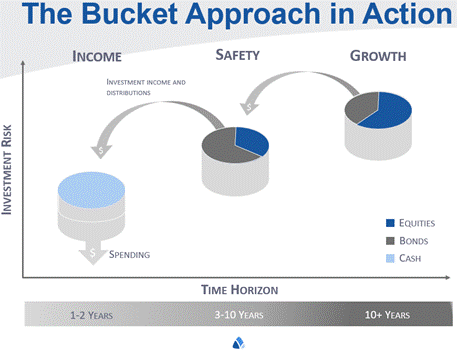Introduction
Retirement is a significant milestone in one’s life, and ensuring a comfortable and stress-free post-retirement existence requires careful financial planning. The “bucket strategy” has emerged as a popular approach to managing retirement savings, offering a structured way to generate income while protecting the principal.
Understanding the Bucket Strategy
The bucket strategy involves dividing your retirement corpus into two or three distinct buckets, each with a specific risk profile, time horizon, and purpose. This approach allows you to balance your need for income with the desire to preserve your capital.
The Three-Bucket Approach
A common three-bucket approach includes:
- Short-Term Bucket: This bucket is designed to cover your immediate and short-term expenses, such as groceries, utilities, and healthcare costs. It typically invests in low-risk, liquid assets like savings accounts, money market funds, or short-term bonds.
- Medium-Term Bucket: This bucket is intended to cover your medium-term expenses, such as vacations, home renovations, or unexpected medical bills. It invests in moderate-risk assets, such as intermediate-term bonds or balanced funds.
- Long-Term Bucket: This bucket is designed to provide a sustainable income stream throughout your retirement. It invests in higher-risk, growth-oriented assets, such as stocks or equity funds.
Benefits of the Bucket Strategy
- Income Generation: By strategically allocating your savings across different buckets, you can generate a steady income stream to meet your ongoing expenses.
- Risk Management: The bucket strategy helps you manage risk by diversifying your investments across different asset classes and time horizons.
- Flexibility: The approach allows you to adjust your investment strategy based on your changing needs and market conditions.
- Preservation of Capital: By maintaining a portion of your savings in low-risk assets, you can protect your principal from significant losses.
Implementing the Bucket Strategy
To effectively implement the bucket strategy, consider the following steps:
- Assess Your Needs: Determine your expected retirement expenses, including housing costs, healthcare, and lifestyle expenses.
- Set Investment Goals: Establish clear investment goals for each bucket, such as generating income, preserving capital, or growing your savings.
- Allocate Your Savings: Divide your retirement corpus among the different buckets based on your needs and risk tolerance.
- Rebalance Regularly: Monitor your investments and rebalance your portfolio periodically to ensure it aligns with your goals and risk tolerance.
Additional Considerations
- Inflation: Consider the impact of inflation on your retirement income and adjust your investment strategy accordingly.
- Tax Implications: Be aware of the tax implications of withdrawing funds from your retirement accounts.
- Sequence of Returns Risk: Be mindful of the sequence of returns risk, which can impact your retirement income if you experience significant market downturns early in retirement.
Conclusion
The bucket strategy offers a practical and effective approach to managing your retirement savings. By carefully planning and implementing this strategy, you can increase your chances of achieving a comfortable and financially secure retirement.
Read more:How to Avoid Mutual Fund Overlap and Protect Your Investments



GIPHY App Key not set. Please check settings